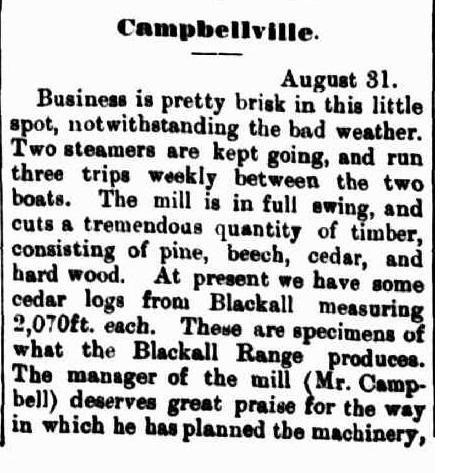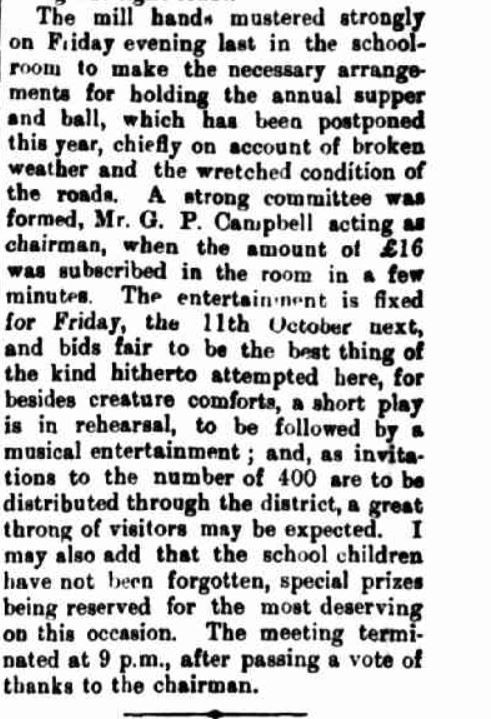Campbellville: the vanished sawmilling town of the Sunshine Coast
By Christina Ealing-Godbold, Research Librarian | 13 January 2023
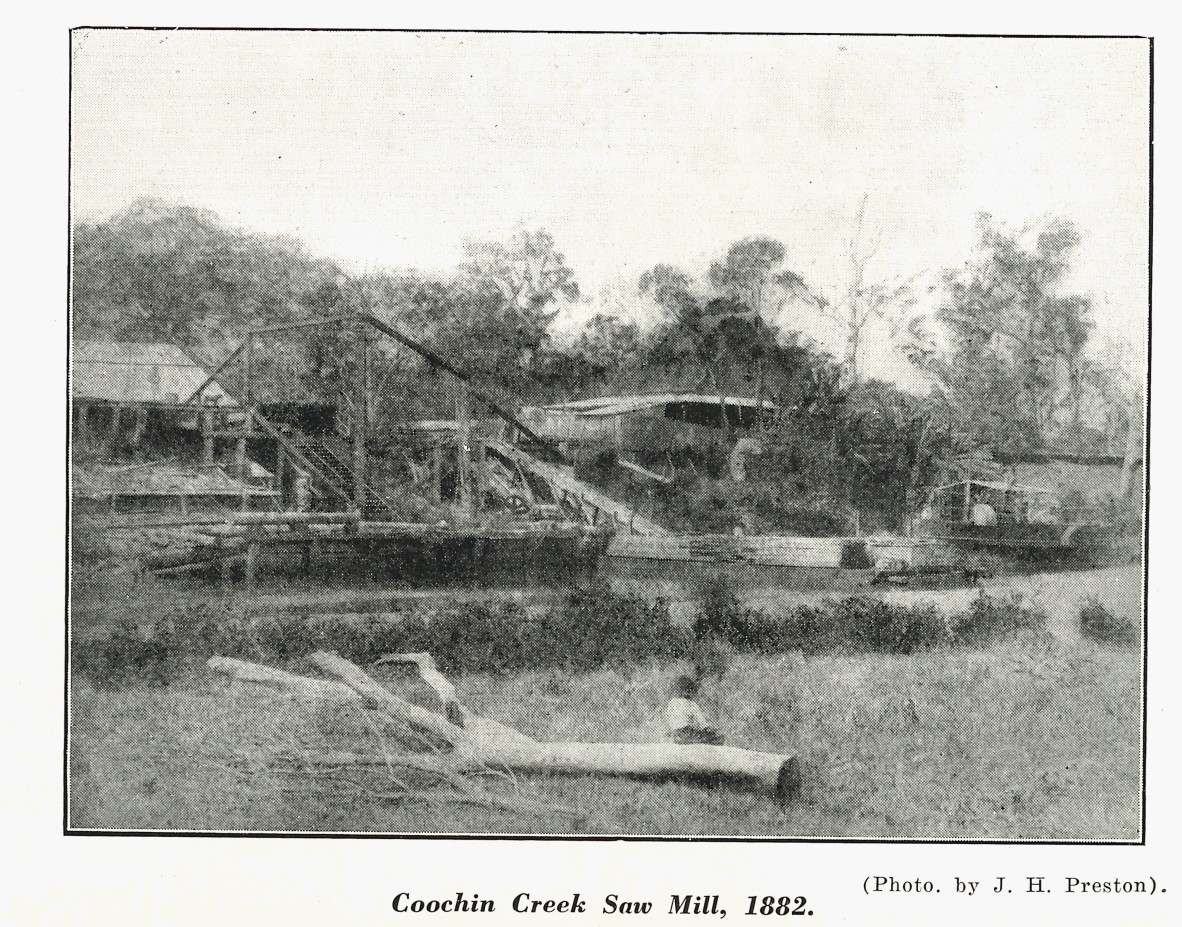
Image of Campbellville. The stern of the paddlewheeler can be seen on the right hand side of the photograph. Bribie : the basket maker by Thomas Welsby, 1937. J 994.31 WEL, p 78. John Oxley Library, State Library of Queensland.
On the way to the Sunshine Coast, between Wild Horse Mountain and just south of the new city of Aura, another thriving settlement existed 130 years ago known as Campbellville. James Campbell established the first sawmill in this region at Coochin Creek in 1881. Situated on the north bank of the navigable creek, on portion 22 and 22A of the Parish of Bribie and 4 miles upstream from its meeting with Pumicestone Passage, the town of Campbellville was home to up to 100 men and their families living in the settlement. In January 1886, The Brisbane Courier newspaper noted that "this firm has done wonders for the district…they pay away every month to people working in the district 1,000 pounds in hard cash.”
The income for this enterprise came from the sale of exquisite timber – cedar, bunya pine, and hardwoods, taken from the Blackall Range and bought by bullock teams from the bottom of the range to the rafting ground. Rafts of logs were piloted to the sawmill, and then taken by boat to the markets in Brisbane. James Campbell had a number of boats to take the wood to market from Coochin Creek – most notably the paddlesteamer “Mavis” piloted by Mr Bill Tutty.
In the “Australian Dictionary of Biography”, the entry on James Campbell notes:
In the 1870s he began milling and selling timber procured initially near Brisbane and Ipswich. He also purchased several ships and built up a thriving shipping trade. The firm James Campbell & Sons was founded in 1882......The exhaustion of local timber forced Campbell to cover much of the coast from Gympie to Kyogle, New South Wales, with numerous mills. The sawn timber was shipped to the firm's wharf near Creek Street in its own ships..... Of his sons, John Dunmore (1854-1909) was born in Brisbane on 19 April 1854 and was baptized by Rev. John Dunmore Lang. Educated at the Brisbane Normal School, he left early to join his father's business. He received a partnership in James Campbell & Sons and when the firm became a limited company in 1896 was appointed chairman and managing director. Particularly interested in the timber trade, he spent many years in the north coast district mainly at the firm's Coochin Creek sawmill, Campbellville. A strong advocate of reafforestation, he was elected to the Caboolture Divisional Board in 1883 and urged the government to open up the district with a railway.
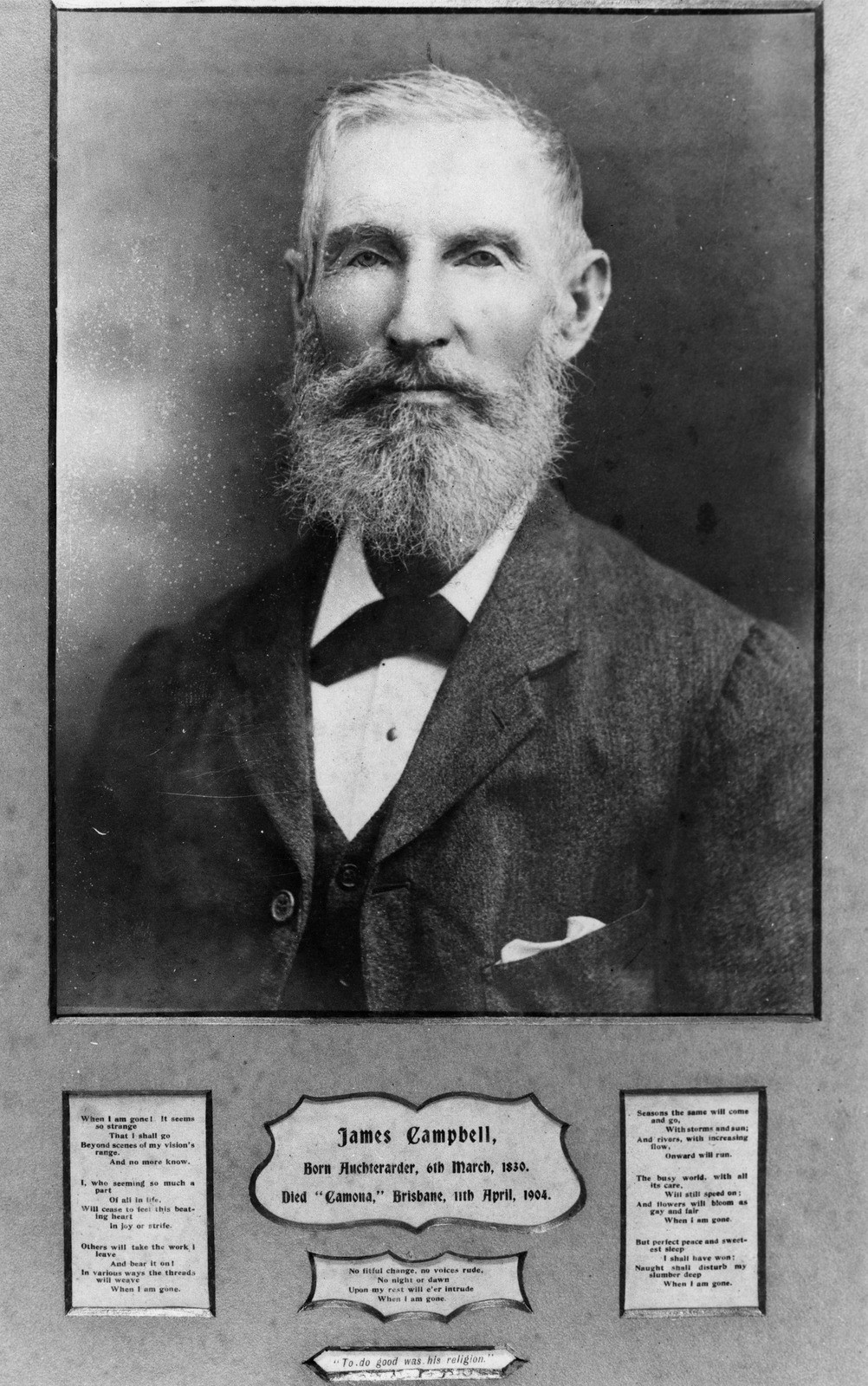
James Campbell. John Oxley Library, State Library of Queensland. Neg 43552.
Campbellville was gazetted as a village in 1877, the mill opened in 1881 and closed in December 1893. Wendy Dixon, in her book on the timber industry in the Landsborough area wrote that “Cedar cutting in the Maleny area started in the 1870s and lasted a short 14 years….Isaac Burgess, Joe Eyles, Francis Dunlop and others were cutting cedar for Campbellville from 1879 “ ( p1). It is also noted that “early timber mills were sited near water supplies in order to provide steam power.” (p2) There was certainly plenty of water on Coochin Creek and adjacent Mellum Creek.
On his journey up Pumicestone Passage in 1937, Thomas Welsby wrote in his book “Bribie, the Basket Maker” (p78)
We are now approaching the Parish of Beerwah, pass by Long Island, Mangroves thereon, until we reach Coochin Creek. This place is historic, and I must tell of its old time patronage as best I can for here I see the name of J.D.Campbell, the owner of 898 acres of land.
In the early 80s, this firm built a sawmill at Coochin Creek, on a site known as Campbell Ville. Pine, cedar, beech, in fact all scrub timbers were obtained from the Blackall Ranges. Hardwood was obtained from the forest country at the foot of the range even as far north as Eudlo. The sawn timber was placed on pontoons at the mill and taken to what was called the loading ground – down the passage and from there placed on steamers and freighted to Brisbane.
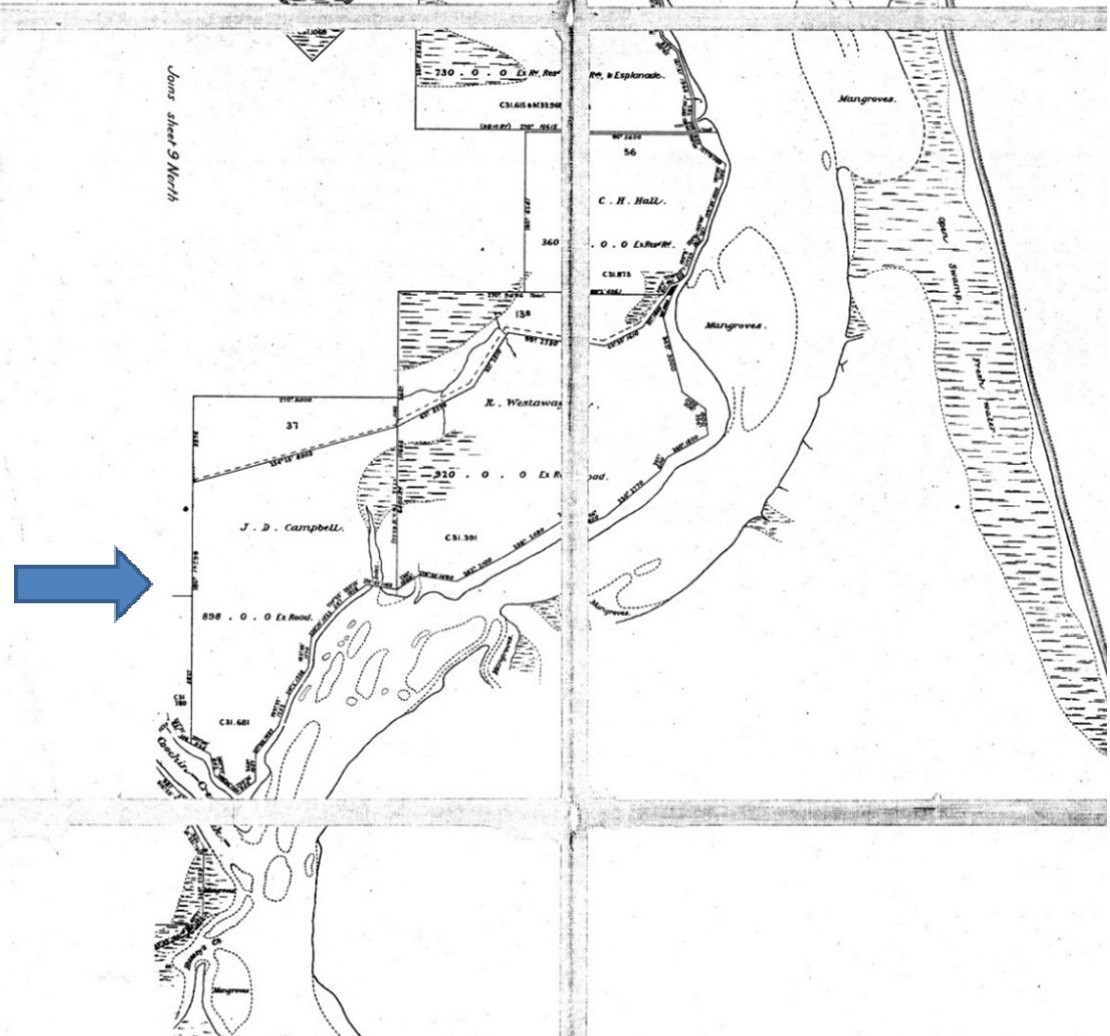
AG2 Moreton Map 8N showing Coochin Creek and J.D.Campbell on the north bank. Queensland Department of Resources.
The town of Campbellville consisted of a steam powered mill, mill house, cranes and wharves and workers houses. A provisional school called “Coochin Creek” with up to 20 students was under the instruction of a series of teachers including Miss Catherine Grace, Miss Annie Ryan and the last teacher, a Mr Murdoch Mackay. The school room doubled as a place for social activities and dances and had a floor built of beautiful crow’s ash timber which was ideal for the sprung floor needed for dancing. Balls were held often, with invitations going out to more than 400 people in the North Coast district. Mr Campbell allowed the mill house to be used for social events as well.
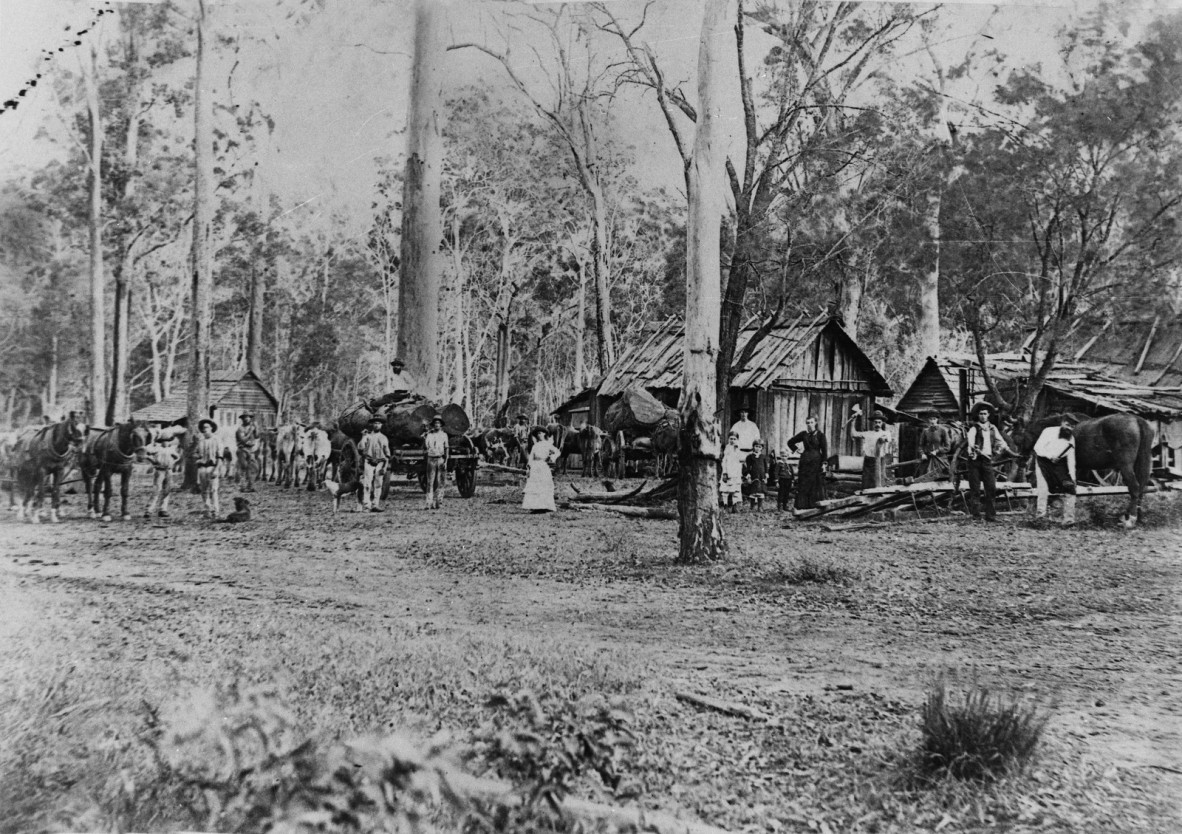
Simpson family home at Coochin Creek, Queensland, ca.1890. John Oxley Library, State Library of Queensland, Neg 168491.
View of the first property owned by the Simpson family. John Simpson was a pioneer timber cutter in the Coochin Creek, Landsborough and Maleny district. There are a number of small slab huts on the property and bullock wagons are loaded with large timber logs. There is a farrier at work on a horse, possibly John Simpson, as he had a blacksmithing workshop on the property. The Simpson family members are pictured outside the home.
The mails were bought by horse three times a week from Landsborough and the town had a post office and store. The post office and store were burnt down in 1894 but the Post Office was announced as being closed in 1891.
A plan of the town (by A.C.Gubby, Department of Primary Industries) based on historical records is detailed below. It shows the school reserve, cemetery, and the approximate sites of the mill, boiler, and wharf.
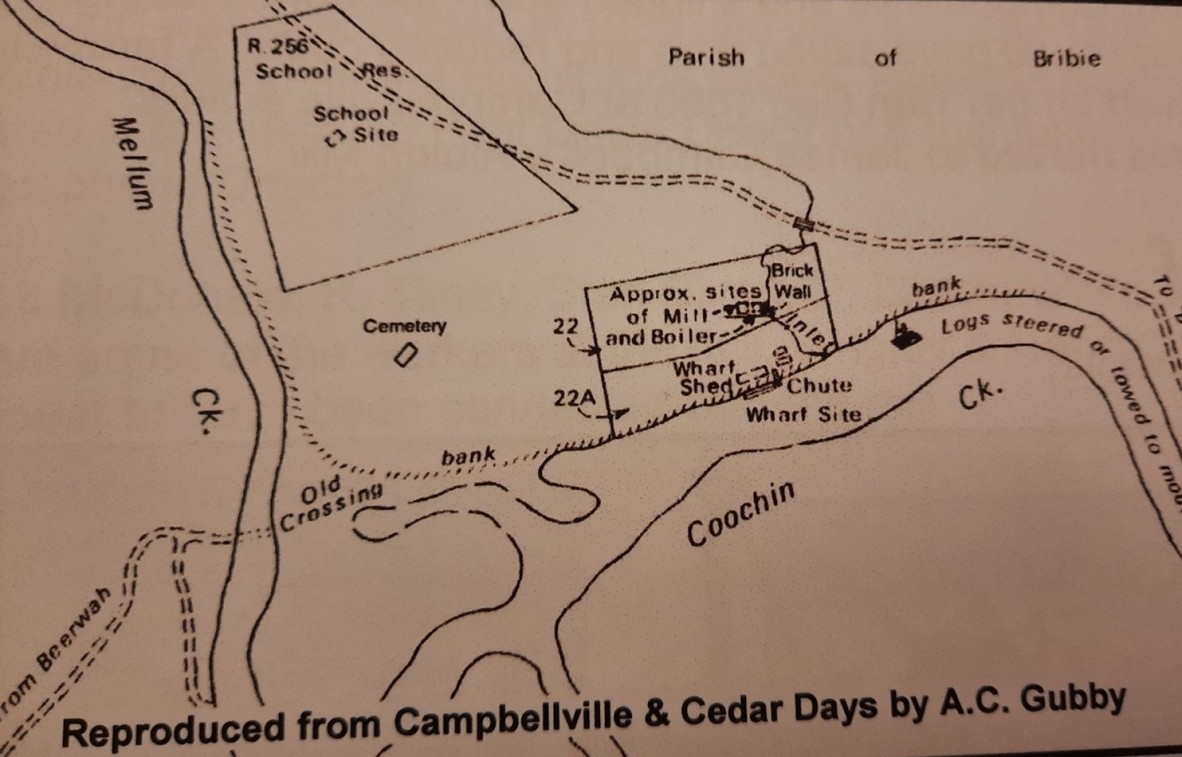
Campbellville and Cedar Days. Campbellville and cedar days : an outline history of the former south-east Queensland sawmilling township of Campbellville and pioneers of the associated timber industry by A.C.Gubby. 1976, p20. John Oxley Library, State Library of Queensland.
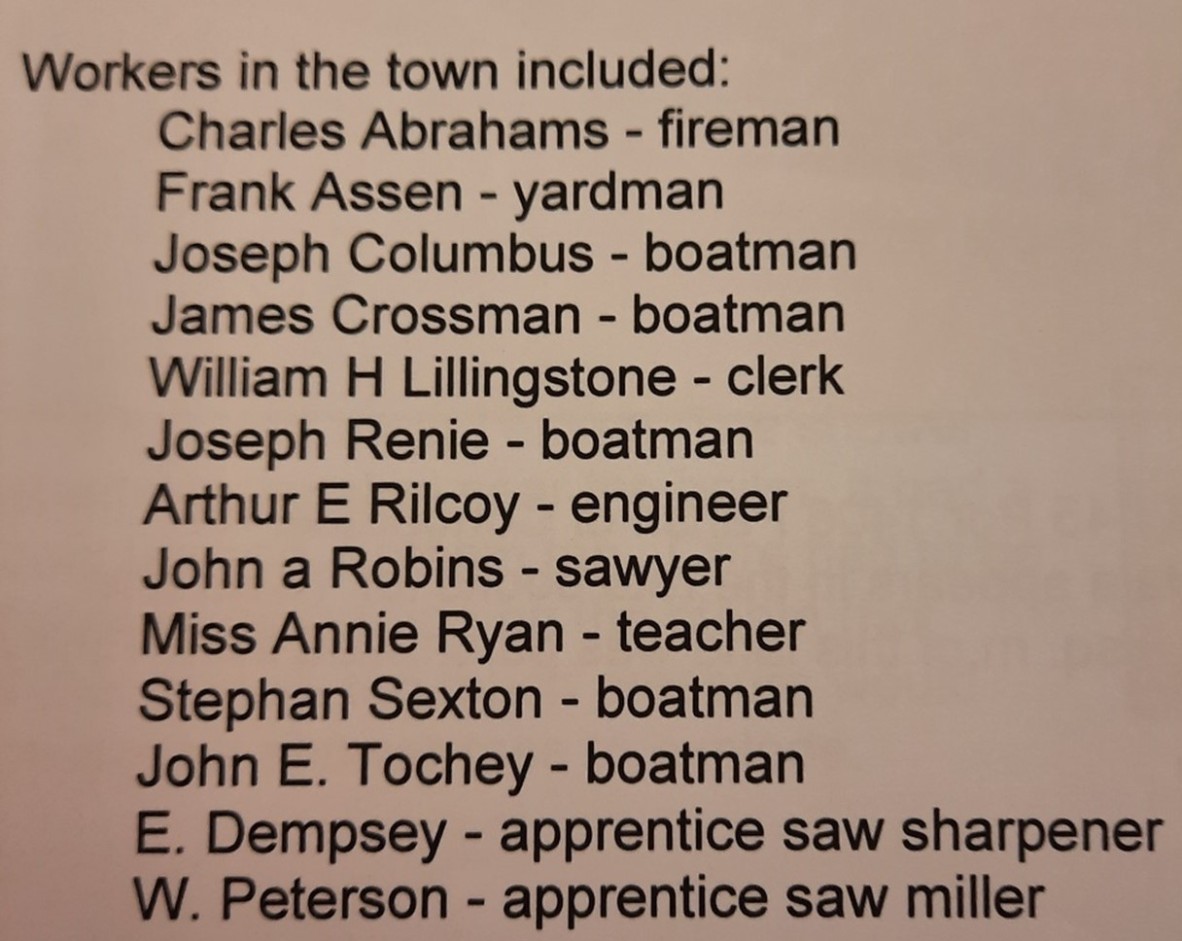
From The Singing of the Saws: The Timber Industry of Landsborough Shire by Wendy Dixon. 2008, p 21. John Oxley Library, State Library of Queensland, Q994.32 DIX.
Every town had to have a cemetery, and indeed, Campbellville had just that. The cemetery is still there and marked accordingly. Only nine graves were identified, some being those of children. One was the grave of Mr Andrew Lovesey who died whilst “step dancing” in the school hall. “Step dancing” is like clogging and was obviously a vigorous activity. There was a formal inquest into this unusual death.
Campbellville was a very social town. It is reported that James Campbell was a believer in improving the working conditions of his staff and gave his workers the “Eight-hour day” without delay, giving them 8 hours of rest, 8 hours of play and 8 hours of work. James Campbell was however opposed to unions – he believed that employers should be benevolent and should “do good for others.” The town had a cricket team, an athletics club, a football team and the whole populace loved dancing. There were dances at Mellum Creek, Campbellville and Caboolture as well as Mooloolah and Beerwah. The social gatherings were reported in the Brisbane Courier frequently throughout the 1880s. The balls consisted of a grand supper, performances of singers and actors and then the floor was cleared for dancing until the “wee hours.”
The Campbellville Cricket team was successful in the region and the pride of the town. However, the evening dances often delayed the teams from their competitions as on this occasion in 1889 when three team members were too tired and/or hungover to join the rest of the team. The Athletic club was also an important part of the community and they too had dances. It was a town where there was much to do, and Mr Earlenberg, the musician must have been very busy indeed!
Cricket Chatter. Moreton Mail (Qld. : 1886 - 1899, 1930 - 1935) 29 November 1889, p7.
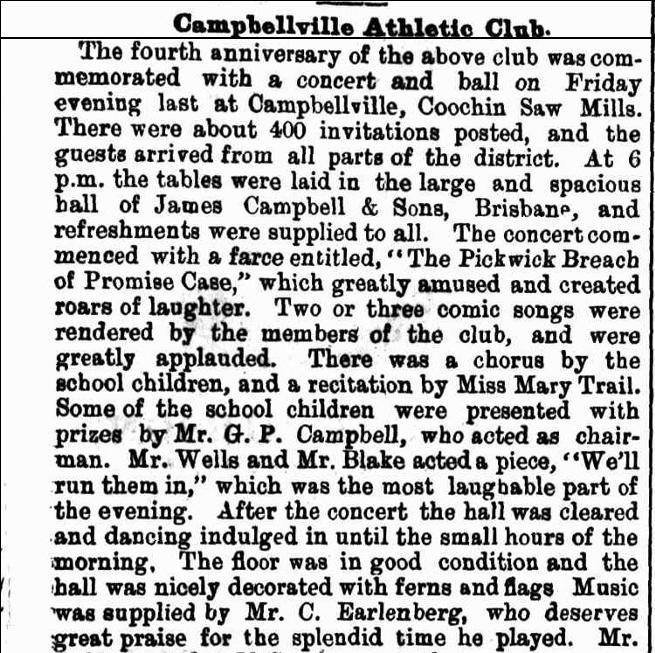
Campbellville Athletic Club. Queensland Figaro and Punch (Brisbane, Qld. : 1885 - 1889) 19 October 1889, p11.
After the opening of the railway, James Campbell and his sons moved the mill to Albion in Brisbane. With the work gone, families moved onto other mill or timber getting towns. Some of the buildings were then reportedly moved to Caloundra, and others taken by bushfire in the dry seasons of 1894 and 1902. John Kerr in his work “Forest Industry Heritage Places Study” in 1998 wrote of the demise of the mill and the town:
Since the sawmill was 4 miles east of the railway, opened in 1890 and the timber came from west of the railway, it spelled the end of the sawmill, which closed in 1893.
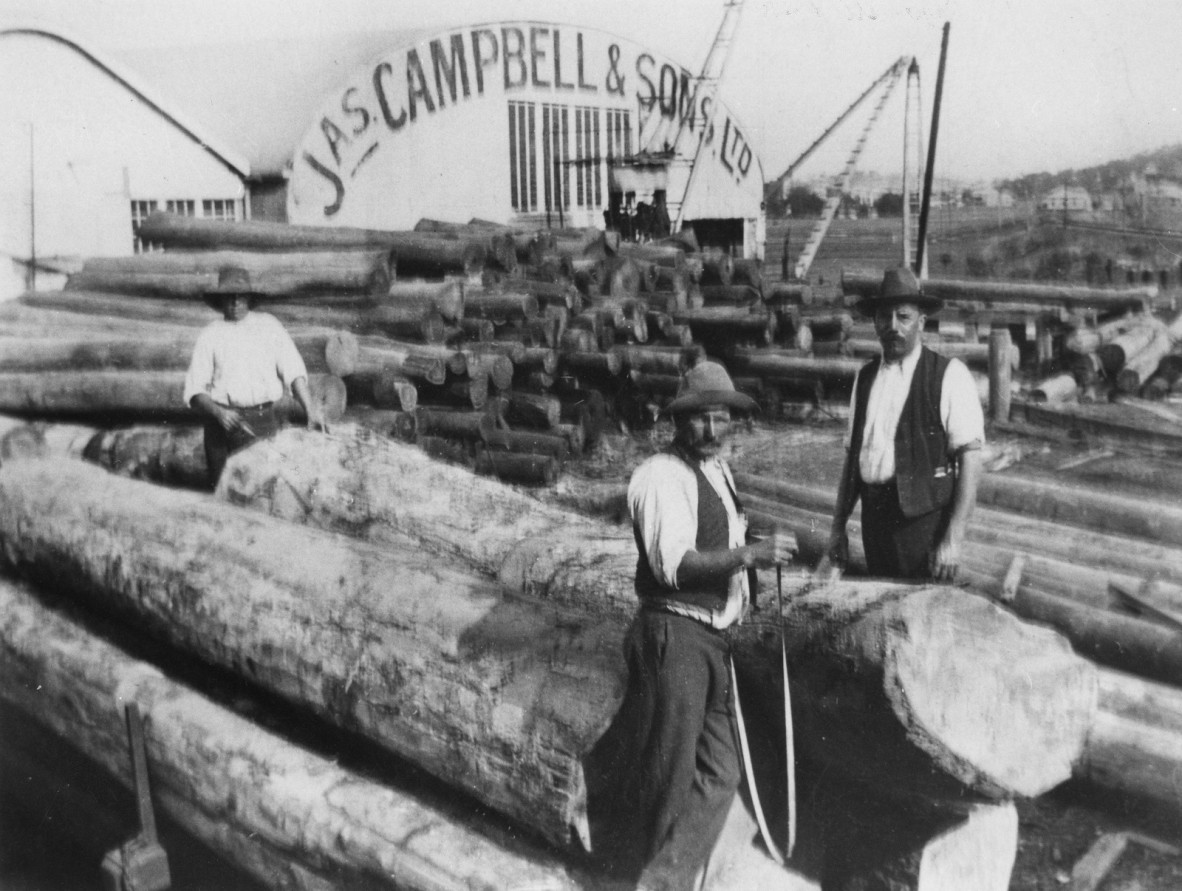
Sawmill owned by James Campbell & Sons at Albion, 1908. John Oxley Library, State Library of Queensland. Neg 151589.
James Campbell and Sons still logged softwoods and pine in the area up until the 1930s but the timber was railed to Brisbane for milling. The Campbell family kept a holiday house at the mouth of Coochin Creek, called “The Bar House”. The Bar House was later leased for holiday accommodation.
During the 1930s depression, the land east of Beerwah was planted with exotic pine species by unemployed relief workers, using stock from a state plant nursery at Beerwah.
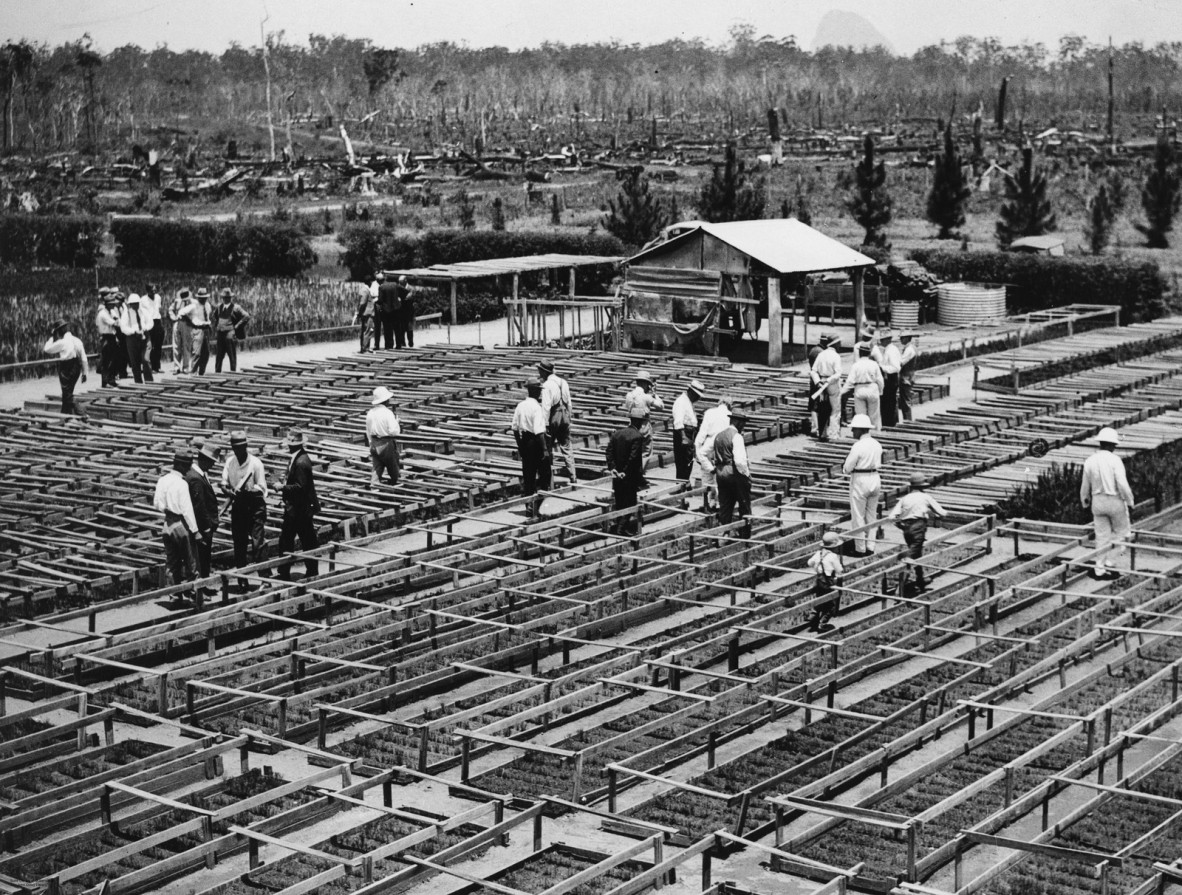
Inspection of pine tree seedlings near Beerwah, Queensland, 1932. John Oxley Library, State Library of Queensland. Neg 190371.
The Pine forests gradually took over the land in the area previously known as Campbellville. Coochin Creek became a haven for fisherman who are expert at navigating their way through the Bribie Pumicestone passage. Today, the town of Campbellville is marked by a “day use recreation area” on the creek and markers and a sign indicate to visitors that an active, thriving timber town once existed on this spot.
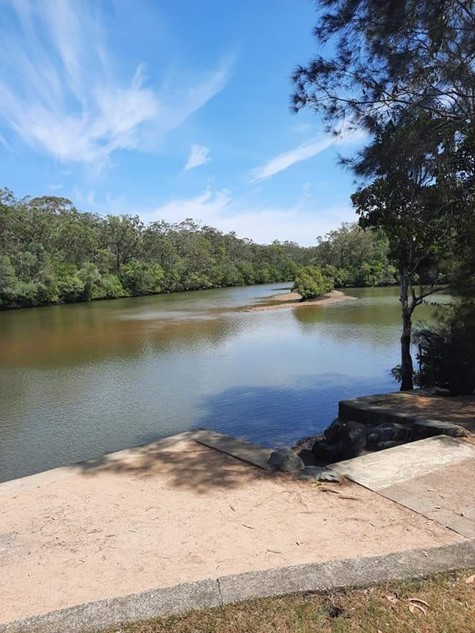
Campbellville site, at the confluence of Coochin and Mellum Creeks in 2021. Photograph courtesy of Christina Ealing-Godbold.
Christina Ealing-Godbold, Research Librarian, State Library of Queensland.
Further Reading
- Campbellville and cedar days : an outline history of the former south-east Queensland sawmilling township of Campbellville and pioneers of the associated timber industry by A.C Gubby. Queensland Department of Forestry, 1976.
- The singing of the saws : the timber industry of Landsborough Shire by Wendy Dixon. Landsborough and District Historical Society Inc, 2008.
- 3909 James Campbell & Son Pty Ltd Records, John Oxley Library, State Library of Queensland.
- Read other blogs by Christina Earling-Godbold.
Comments
Your email address will not be published.
We welcome relevant, respectful comments.
